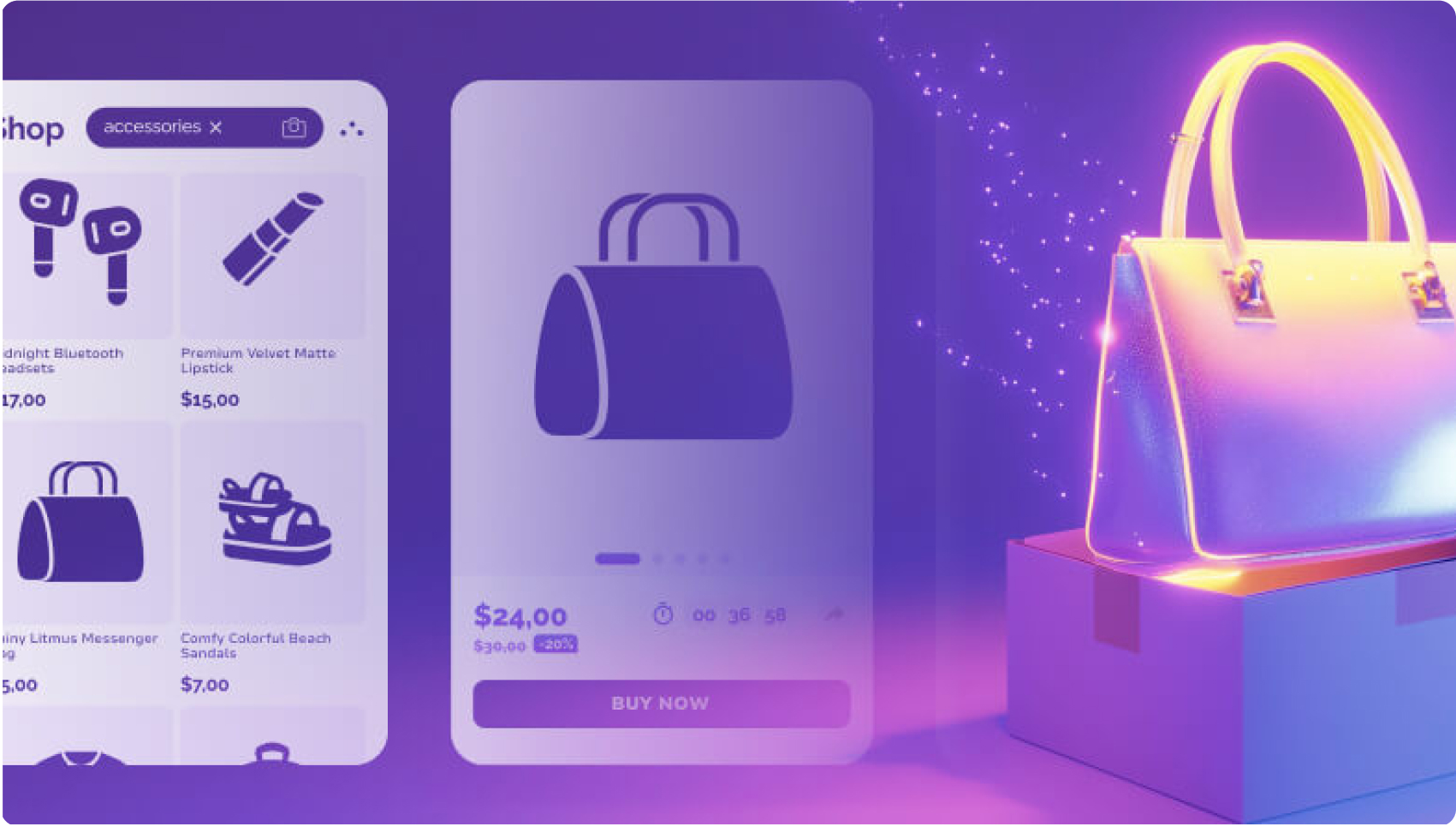
Dropshipping is a simple business model. It lets you sell products without the usual retail challenges of stocking up, storing, and shipping physical inventory. Instead, after making a sale, the order is sent directly to the supplier, who delivers it to the customer.
This business model frees up time to focus on marketing and making your store stand out. Continue reading this article to learn how dropshipping works, its pros and cons, revenue potential, case studies, and how to start a dropshipping business.
Dropshipping is a retailing model in which an online seller doesn't stock its products. Instead, orders are sent directly to the supplier, who fulfills them for the buyer. This model outsources the process of procuring, storing, and shipping products, leaving more time and money to focus on branding.The dropshipping model has become increasingly popular with entrepreneurs attracted by the low overhead costs. It’s a lucrative market worth over $300 billion and is projected to reach nearly $500 billion by 2026. However, this business model has unique challenges, which sellers must consider carefully.
“What is a dropshipping business?” Here’s an illustrative answer:
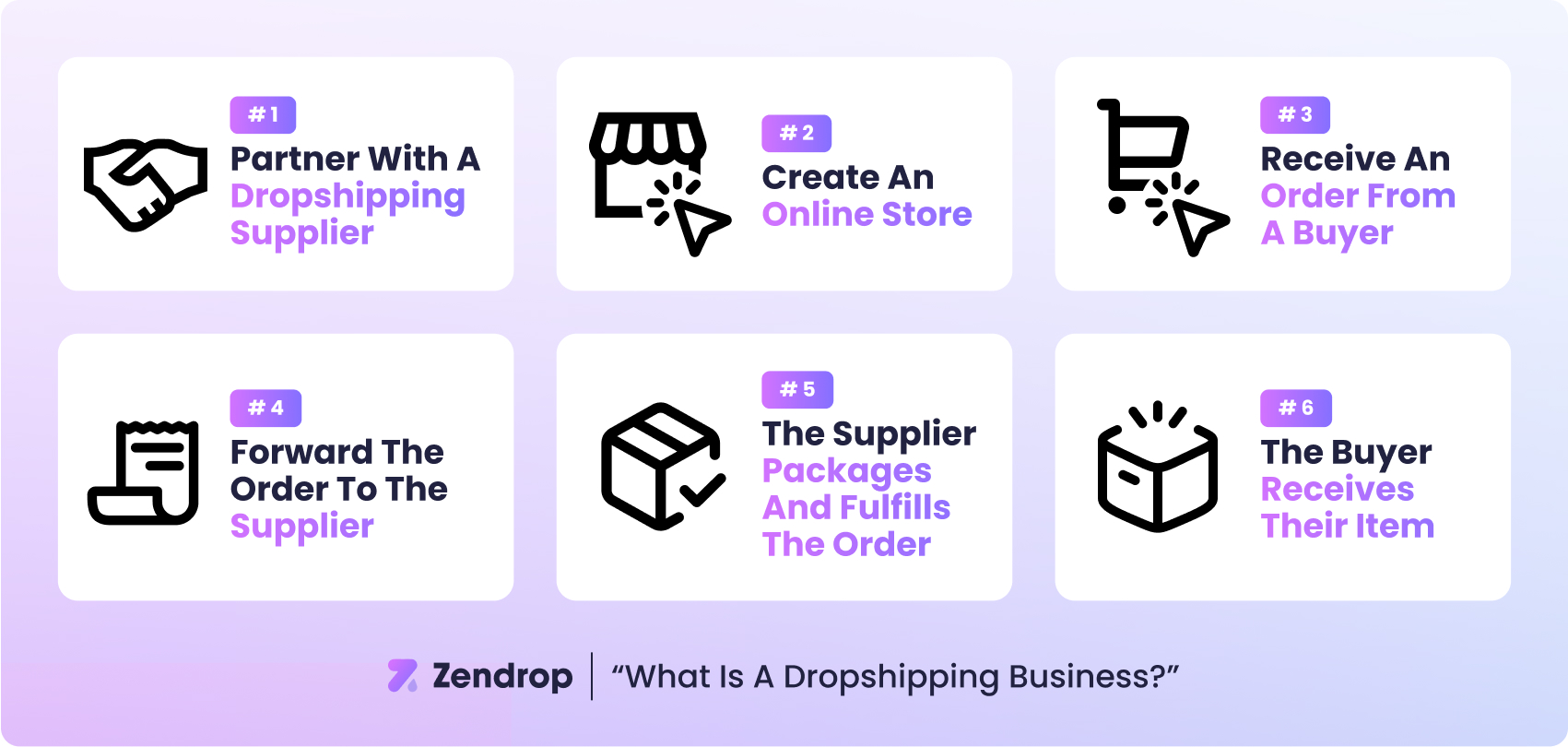
The first step is finding a supplier for the product you want to sell. You'll sign an agreement with the supplier to store, package, and ship the products to your customers. You can choose Zendrop, which connects you directly with manufacturers and factories. Our platform lets you source products directly from their makers and limit exposure to sudden price fluctuations.
Create an online store where you'll list products and receive payments from customers. Shopify, BigCommerce, and Wix are popular platforms for creating online stores with little hassle. However, instead of spending considerable time and money to create a store from scratch, you can choose one of Zendrop’s free, custom-built stores.
When someone visits your store and adds an item to their cart, they follow the checkout process to pay for the item. After payment, they receive a confirmation email and await delivery.
You'll send the order details to your product supplier, including the number of items and the buyer’s address. A dropshipping app can automate this process.
The supplier receives the order details. Then, it packages and ships the product directly to the buyer's address.
The customer receives the products shipped by the supplier. Throughout this process, you didn’t handle any physical inventory. Instead, you served as a middleman between the buyer and the supplier. After paying the supplier for packaging and shipping, whatever is left from the sale price is your profit.
Entrepreneurs are increasingly attracted to dropshipping because of its benefits. These advantages include:
Starting a dropshipping business requires minimal initial capital because you don't have to purchase inventory upfront. Instead, your costs lie primarily in hosting and promoting your online store. You’ll risk less capital because, unlike traditional retail stores, you don’t have to stock goods people may not buy.
Dropshipping enables you to offer a wider range of products than traditional online retail outlets. With no unsold inventory in your hands, you can easily adjust your product catalog to meet new demand. Once a supplier stocks a new item, you can list it for sale on your website.
Conventional retail outlets rent warehouses to stock goods, which can be expensive. The problem worsens if products don’t sell despite occupying valuable warehouse space. But dropshipping avoids this issue. You can operate from anywhere while Zendrop handles your warehousing. Your focus is on communicating with suppliers and resolving customer complaints.
Dropshipping businesses are easier to scale than traditional retail operations, as you can quickly list products in response to customer demand.
You outsource the hassles of storing, packaging, and shipping orders, making the business easier to run. A dropshipping business can run with minimal manpower, unlike traditional stores that require additional staffing when demand increases.
Dropshipping has its drawbacks, which aspiring sellers must consider. They include:
Dropshipping has intense competition because of its low barriers to entry. This tough competition causes lower profit margins, as dropshippers undercut each other on prices to attract customers. However, you can mitigate this issue by carefully curating your products and choosing a niche that’s not oversaturated.
Zendrop gives you access to millions of products. Our platform enables you to carefully select your niche and choose products that help your site stand out.
Relying on external suppliers exposes you to product quality and delivery risks. If a customer orders a product and waits too long to receive it from the supplier, they'll be dissatisfied with your service and likely not purchase more items. A customer might get a product of poor quality from a supplier, giving your store a reputational hit.You can reduce your risk by choosing Zendrop, which offers China and U.S.-based warehousing. Our warehousing services ensure faster shipping and processing, higher quality control, and lower risks of products running out of stock. We also provide custom branding and packaging to help your dropshipping store outperform competitors.
Depending on external suppliers means limited control over your product inventory and packaging. Your supplier might suddenly run out of a high-demand product, making you cancel a customer’s order. Product packaging can also be inconsistent when working with external suppliers.
The good news is that there are ways to mitigate your limited control over inventory and packaging. For example, Zendrop lets you customize your packaging and offers print-on-demand services to fulfill your customers’ requests. We also have warehouses that give you better control over product inventory and storage.
The intense competition in the dropshipping sector makes it difficult to stand out. Dropshippers must put much effort into building a unique brand identity, unlike traditional retailers that can easily stand out with their products. With sellers sourcing products from common suppliers, marketing is the principal way to differentiate your brand. Zendrop helps by offering print-on-demand and customization services to help your store outdo rivals.
You’ve learned what a dropshipping business is and how it works. Starting one requires intricate steps, from finding suppliers to building a store, developing a branding strategy, and setting up payments and delivery processes. Below is a step-by-step guide:
The first step is choosing a profitable niche for your dropshipping venture. Popular niches include phone accessories, auto accessories, fashion, baby bottles, home office products, etc., but what’s popular doesn’t necessarily mean profitable.
Use research tools like Meta's Audience Insights and Google Trends to discover what products people are interested in. Look for statistics, surveys, and case studies to see what niches have growth prospects you can capitalize on.
Accessories tend to be high-margin niches because buyers are less price-sensitive. Someone might spend weeks shopping for a smartphone but won't think twice about spending $30 on a smartphone case. Yet, chances are the seller made more profit margin on the case than the smartphone.Look for trendy products people hardly find in your city or country. Aim for niches with passionate customers, e.g., sustainability products where customers aren’t afraid to pay good prices to prove a point.
With your niche finalized, the next step is to find reliable suppliers in that niche. Before choosing a supplier, analyze previous reviews to check their reputation and product quality. Research dropshipping forums and online communities to evaluate other sellers’ experiences with the supplier.
Zendrop takes the wheel at this step. Our platform connects you directly to a broad product variety in profitable niches. We link you directly to manufacturers to get the best rates and process orders within 1-2 days to ensure fast shipping times. Choosing Zendrop is much better than connecting to suppliers on AliExpress, where you’ll deal with layers of intermediaries that give higher prices and reduce your potential profits. We control our supply chain and link you directly with manufacturers, with no other layer of middlemen that can cause problems.
The next step is to build an online store to list products, receive payments, and communicate with customers. Platforms like Shopify have made this easy. They provide backend infrastructure for your store, while you focus on the design and branding aspects. These platforms have direct integrations with Zendrop and other dropshipping apps, letting you research and list products at the click of a button.You can also set up a store in less than 5 minutes with our AI storebuilder. This AI tool creates a store according to your preferences, and you can make the final touches to match your tastes. It saves considerable time and effort you would have spent creating a store from scratch.
Develop strategies to promote your online store and get sales. Promotion can take different forms, from social media to search engine marketing and website ads. For example, you can collaborate with mini-influencers in your niche. Instagram influencer posts go a long way in building a loyal audience. You can run ads on search engines or display networks like Google AdSense. You can also create a social media page and run direct promotions. Social media, search ads, and display networks let you hyper-target your audience down to age, interests, income level, and search history.
Choose a secure payment processor to receive money from your customers. Your e-commerce platform should provide integrations with various payment processors like Stripe, PayPal, and Klarna (buy now, pay later). Payment processors require identity verification and, in some cases, proof of formal business registration.
Then, choose a secure delivery method to ensure customers receive their items. Shipping providers have different fees and delivery times, so research extensively before choosing.
Dropshipping can be profitable if you play your cards right. However, it's not a gateway to easy money like many entrepreneurs assume, often swayed by social media influencers promoting it as a “passive income” source. It can be profitable, but it takes considerable effort to make your brand stand out and build a loyal customer base.
MVMT is a prominent watch seller with over $50 million in annual sales. It began as a dropshipping business by two entrepreneurs, Jake Kassan and Kramer LaPlante, who had an idea to sell premium-branded watches sourced from China to a U.S. audience.

MVMT’s founders focused primarily on marketing to differentiate their products in an overcrowded wristwatch market. They created an online store with Shopify to list products and collect payments. Crucially, they negotiated directly with the wristwatch suppliers in China instead of picking random suppliers from AliExpress, a mistake dropshippers often make.
Kassan and LaPlante ran extensive social media campaigns, hiring influencers and giving out a free wristwatch for every 1,000 Facebook likes. They started with a small set of products and gradually expanded as time went on.
It didn’t take long for MVMT to succeed. The business, founded in 2013, brought in $1 million in its first year, $30 million in its second, and $60 million in its third year. In 2018, after five years of existence, Kassan and LaPlante sold MVMT for over $100 million.
Over time, MVMT switched from dropshipping to ordering wristwatches from suppliers and storing them in a U.S. warehouse. However, dropshipping gave this brand a solid footing and rewarded its founders financially.
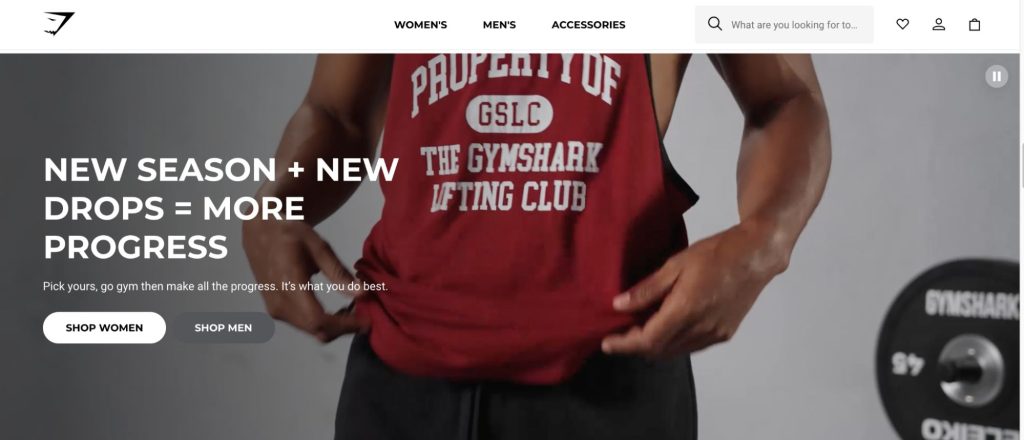
With over $500 million ($600 million) in annual sales, Gymshark is one of the most valuable British fitness brands. Yet, few know that it began as a dropshipping site selling bodybuilding supplements before branching into fitness apparel.
Gymshark leveraged social media to transform from a small dropshipping business into a global brand. It partnered with social media influencers to advertise its fitness apparel, starting with a Luxe tracksuit that went viral on Facebook. Gymshark reiterated heavily in response to customer demand, thanks to its robust network of foreign suppliers.
Today, Gymshark works directly with many Asian manufacturers, and its products adorn millions of customers worldwide. The company has built a loyal customer base through influencer and community marketing. It demonstrates the power of leveraging social media to create a formidable dropshipping business.
The product you sell is the primary factor affecting dropshipping profitability. You need an in-demand product for which you can easily find buyers. Some products have higher profit margins than others, i.e., those where branding is the main differentiating factor instead of utility. A good example is cosmetics, which have enormous demand, and customers are willing to pay premium prices for brands they love.
Suppliers are the backbone of a dropshipping business, so establishing quality relationships with them is vital. Seek reliable suppliers with high-quality products and timely shipping to satisfy customers. The happier customers are with your service, the more willing they are to purchase new products.
Your marketing strategy determines whether the right audience sees and purchases your product. You need effective social media marketing and search engine optimization to drive profitability.
Like any other business, dropshipping requires keeping operational costs minimal to increase profit margins. Aim to achieve more with less budget, whether for website hosting, marketing, or product selection. Closely monitor your operational costs to avoid running over budget.
Customer service is an effective way to outshine competitors. Offer excellent support to your customers, promptly answering their questions and attending to their shopping requests. People might ask detailed questions before ordering a product or need help ordering a product. Every customer counts, so offer first-rate service to make them happy.
Contrary to popular belief, increasing prices doesn’t always result in reduced sales, especially when you’ve built a loyal customer base. You can occasionally raise prices for highly demanded products to boost your profitability. Carefully watch your competitors to see what prices customers are willing to pay for high-quality products.
High-margin products boost your chances of building a profitable dropshipping business. We’ve mentioned cosmetics as an example where people are willing to pay more for their favorite products. Other examples are jewelry, home decor, and phone accessories.
As a business owner, focus on profit margins, not revenue. The aim is to buy low and sell high, giving you profits you can further invest in the business.
Some dropshippers hastily choose suppliers without vetting their credibility, quality, and reliability. This mistake is common among new entrepreneurs who are too excited to launch their dropshipping business and have little patience to vet suppliers properly, but it causes long-term problems.
You should conduct extensive research before choosing a supplier who can make or break your dropshipping business. What do other dropshippers say about them? Do they have a history of delivering high-quality products? Do they offer speedy delivery? These are crucial questions to answer before selecting a supplier.
Zendrop solves this issue by offering vetted suppliers with high quality and reliability. Our platform connects you directly to manufacturers that ship within 3 to 5 business days. You can automate your fulfillment process and get more time to focus on promotion and customer service.
Dropshippers often overprice their products and struggle to find customers or underprice their products and reduce potential profits. A good way to set prices is to research your competitors and use their pricing as a guide. You can also set a fixed dollar or percentage markup on the supplier's price, e.g., cost of product + $5 or cost of product plus 20%.
Competitive pricing helps you attract customers shopping for good deals. Fixed markup pricing helps you get consistent profits and grow your business.
Many dropshippers overlook customer service, but this is crucial to outclassing competitors and building a loyal customer base. You should be attentive to customer complaints and go the extra mile to help them resolve their problems. This might seem stressful, but it helps you build a loyal customer base and boost sales.
Accepting refunds and returns can be complex when the buyer has to send the item back to the supplier in a faraway place. However, you can mitigate this by letting the buyer keep the product despite getting a refund. To prevent potential abuse of this model, have a concise return policy outlining the conditions for getting refunds. This policy should be on a separate web page accessible from a footer link.
Here’s an example of how a return policy should look on your dropshipping website:

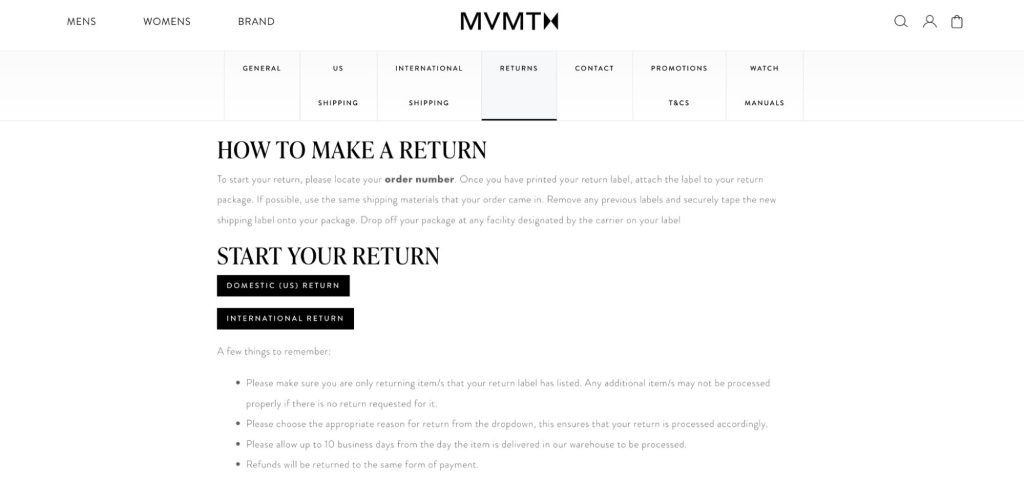
Dropshipping can be lucrative if done correctly, but it might not be the best business model for you. Here are some alternative ways to sell products online:
You can outsource product warehousing and shipping to a local third party instead of relying on suppliers not geographically close to your customer base. This method gives you control over inventory, branding, product quality, and shipping times, but the third party handles the logistics for a fee. Zendrop offers third-party logistics solutions with warehouses in China and the U.S. We handle warehousing, shipping, and inventory management for dropshippers, giving you time to focus on branding and customer service.
You can develop private-label products made by a third party but sold under your brand name. Private label products are designed specifically for your brand, making it easier to build a distinct identity and loyal following.
For example, you can sell a collection of bathroom products (soap, toothpaste, and body cream) and build a distinct brand name. The key is finding a supplier that delivers stellar product quality. You can control the branding and inventory and outsource logistics to a third party. Private-label products have high profit margins because people are willing to pay more for a brand they love.
Instead of being the direct seller, you can focus on promoting other brand's products and earning commissions. This model is called affiliate marketing, wherein you promote products and earn a percentage of every sale. Average commission rates are between 5% and 30%, with most businesses starting on the lower end and increasing it as you prove your effectiveness.
Affiliate marketing has low startup costs like dropshipping, and you can start with a small audience. The focus is on building and monetizing an audience by recommending relevant products.
In affiliate marketing, you’ll promote a merchant’s product and receive a percentage of their sales. It starts by signing up on an affiliate network that gives access to high-paying offers. Then, you’ll choose the offers to promote, with commissions agreed beforehand.
For every product, the affiliate network issues a link with a custom ID that identifies your account. If someone visits this link and buys the product, you’ll be recorded as the referrer and collect the agreed commission. You can promote affiliate products on a blog, website, or social media page. The key is building authority in a niche and promoting products related to that niche.
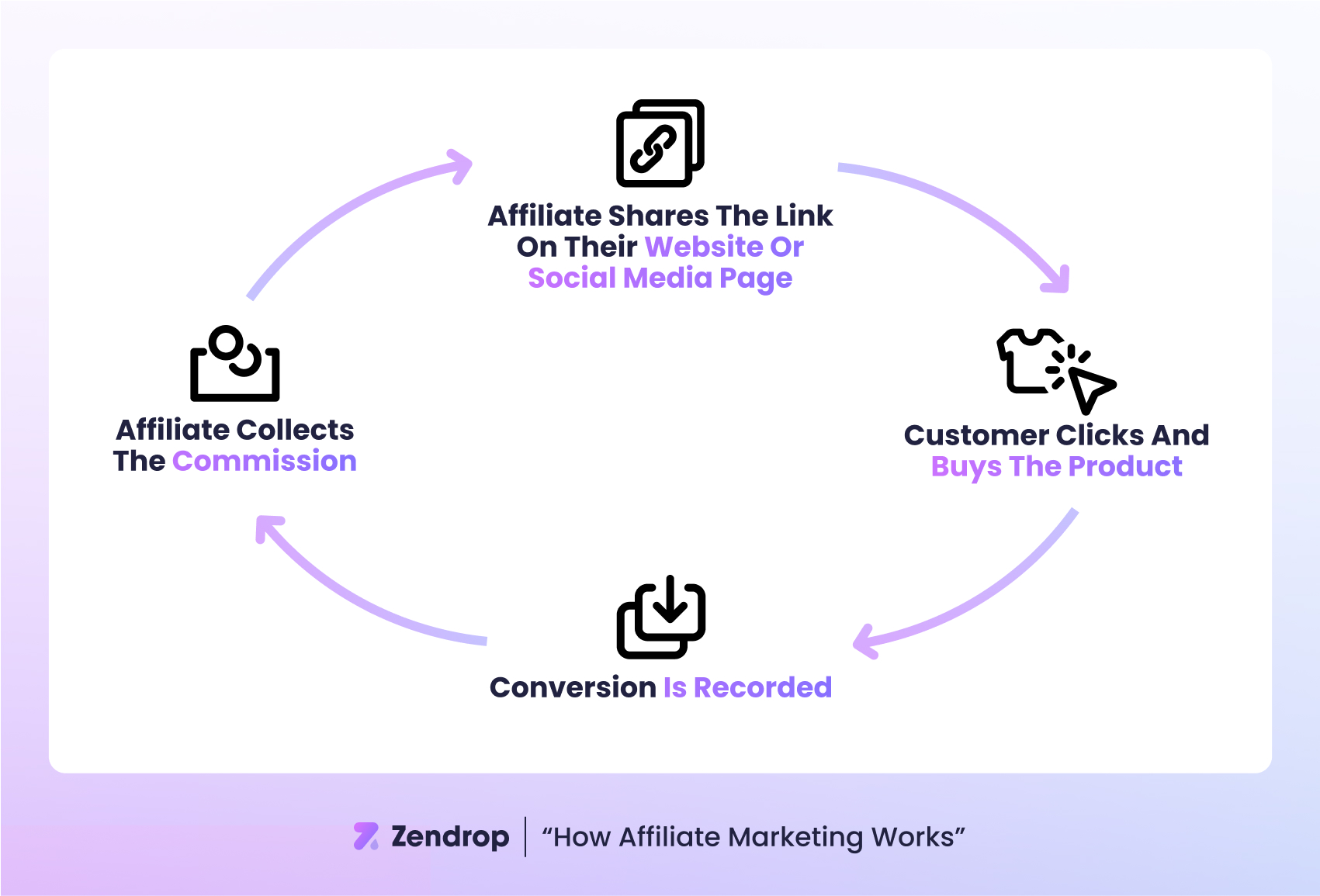
For example, someone passionate about smartphones can create a blog to discuss new smartphones and their specifications. Then, they’ll insert affiliate links for smartphones they write about. When a reader follows this link and buys the recommended smartphone, the blog owner gets a commission.
Affiliate marketing is easy to start, and there's no need to manage customer support. It requires similar skill sets as dropshipping, primarily marketing and advertising. However, there’s a core difference: your affiliate commission is determined by the merchant, but dropshippers are free to set prices and increase their profits.
Dropshipping is a popular choice for entrepreneurs seeking to launch new businesses. It has its pros & cons, and there are crucial considerations when launching a dropshipping business. The key is finding a reliable supplier to fulfill your orders while you focus on branding and customer service.
Zendrop empowers you to find the best suppliers for your dropshipping business. A Zendrop Plus subscription gives you access to 1 million+ products, custom branding, product bundles, fast shipping times, and many other dropshipping benefits. Kickstart your dropshipping business today with a subscription.
You generally do not need a business license to begin a dropshipping business. However, in some jurisdictions, you need a retail license if your sales volume hits a specific threshold. You might also need a reseller permit to sell some products without incurring additional sales tax.
Zendrop is one of the best platforms for dropshipping. It connects you to a sturdy supply chain of 1 million+ unique, fast-delivery products. Its manufacturer network and custom branding solutions empower users to build a high-volume dropshipping business without hassles.
Yes, many wholesalers and manufacturers ship internationally on behalf of dropshippers. Zendrop connects you to manufacturers and handles global fulfillment with industry-leading shipping times.
You can make significant income from dropshipping, but it depends on the products you select and the effectiveness of your marketing strategy. Like most businesses, dropshipping doesn’t guarantee you income, but it can be lucrative if you play your cards right.
Dropshipping involves selling products you don't physically have, as the supplier handles storage and shipping. In contrast, wholesalers purchase goods in bulk, store them, and resell them to other customers. Retailers purchase goods in small quantities, store them, and resell them for profit.
Popular dropshipping products include apparel, car accessories, home tools, cosmetics, travel bottles, furniture, and pet supplies. These are everyday items people purchase frequently, enabling you to build a long-term customer base.
